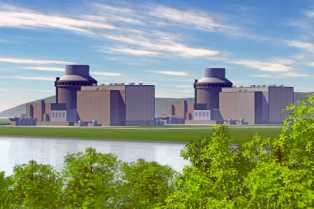US utilities Progress Energy and Duke Energy have announced that they are to merge, creating the country's largest utility which will also have the largest regulated nuclear fleet in the country.
 |
The planned Levy plant (Image: Progress Energy) |
Progress brings to the new utility nearly 22.6 GWe of capacity, including 4.3 GWe of nuclear from five reactors including two boiling water reactors (BWRs) at Brunswick and single pressurised water reactors (PWRs) at Crystal River, Harris and Robinson. It is also planning to build two Westinghouse AP1000s at a new site at Levy, Florida, although last year it announced that major construction activities were being postponed at the site pending the receipt of a licence for the plant. It also submitted a combined construction and operating licence (COL) for two AP1000s at its existing Shearon Harris plant.
Duke Energy operates seven PWRs in North and South Carolina (two each at Catawba and McGuire and three at Oconee) representing a total capacity of 6.7 GWe. It is also planning to build two AP1000s at the William States Lee site in South Carolina and has been linked with possible plans to build a new nuclear power plant at the former Piketon uranium enrichment plant site in Ohio.
On completion of the merger, which the companies are expecting to achieve by the end of 2011, Duke Energy's current president and CEO Jim Rogers will be the new organisation's executive chairman, while Progress Energy chairman, president and CEO Bill Johnson will become its president and CEO. In the meantime, the companies will continue to operate as separate entities.
Rogers said that the merger would enable the companies to invest in future building and investment projects more economically. "Combining Duke Energy and Progress Energy creates a utility with greater financial strength and enhanced ability to meet our challenges head-on," he said. Meanwhile, Johnson said the two companies fitted together naturally. "It makes clear strategic sense and creates exceptional value for our shareholders," he said of the merger.
After the merger is complete, it is anticipated that Duke Energy shareholders will own approximately 63% of the combined company, and Progress Energy shareholders the remaining 37%. The merger is conditional upon shareholder approval and necessary regulatory filings.
Researched and written
by World Nuclear News




_91467.jpg)
_47120.jpg)
_16439.jpg)






